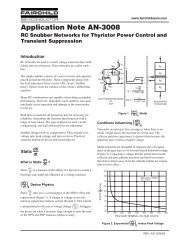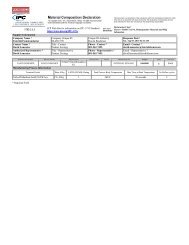Half-Bridge LLC Resonant Converter Design Using FSFR-Series ...
Half-Bridge LLC Resonant Converter Design Using FSFR-Series ...
Half-Bridge LLC Resonant Converter Design Using FSFR-Series ...
You also want an ePaper? Increase the reach of your titles
YUMPU automatically turns print PDFs into web optimized ePapers that Google loves.
AN-4151 APPLICATION NOTE<br />
Vin<br />
(From PFC<br />
output)<br />
C DL<br />
R max<br />
Vcc<br />
R min<br />
C B<br />
C LVcc<br />
R LPF<br />
R SS<br />
C SS<br />
RT<br />
CON<br />
CS<br />
C LPF<br />
R sense<br />
LVcc<br />
R damp<br />
Control<br />
IC<br />
D boot<br />
VDL<br />
SG PG<br />
© 2007 Fairchild Semiconductor Corporation www.fairchildsemi.com<br />
Rev. 1.0.1 • 5/15/12 8<br />
Cr<br />
HVcc<br />
C HVcc<br />
V CTR<br />
L lkp<br />
Lm<br />
L lks<br />
Np Ns<br />
Integrated<br />
transformer<br />
Ns<br />
L lks<br />
D1<br />
D2<br />
R bias<br />
KA431<br />
Figure 17. Reference Circuit for <strong>Design</strong> Example of <strong>LLC</strong> <strong>Resonant</strong> <strong>Half</strong>-bridge <strong>Converter</strong><br />
5. <strong>Design</strong> Procedure<br />
In this section, a design procedure is presented using the<br />
schematic in Figure 17 as a reference. An integrated<br />
transformer with center tap, secondary side is used and<br />
input is supplied from power factor correction (PFC) preregulator.<br />
A DC/DC converter with 192W/24V output has<br />
been selected as a design example. The design<br />
specifications are as follows:<br />
- Nominal input voltage: 400VDC (output of PFC stage)<br />
- Output: 24V/8A (192W)<br />
- Hold-up time requirement: 20ms (50Hz line freq.)<br />
- DC link capacitor of PFC output: 220µF<br />
[STEP-1] Define the system specifications<br />
As a first step, define the following specification.<br />
Estimated efficiency (Eff): The power conversion<br />
efficiency must be estimated to calculate the maximum<br />
input power with a given maximum output power. If no<br />
reference data is available, use Eff = 0.88~0.92 for lowvoltage<br />
output applications and Eff = 0.92~0.96 for highvoltage<br />
output applications. With the estimated efficiency,<br />
the maximum input power is given as:<br />
P<br />
P<br />
o<br />
(11)<br />
in<br />
E ff<br />
Input voltage range (Vin min and Vin max ): The maximum<br />
input voltage would be the nominal PFC output voltage as:<br />
V V<br />
(12)<br />
max<br />
in O. PFC<br />
Even though the input voltage is regulated as constant by<br />
PFC pre-regulator, it drops during the hold-up time. The<br />
minimum input voltage considering the hold-up time<br />
requirement is given as:<br />
2PinTHU DL<br />
C o<br />
R d<br />
C F<br />
R F<br />
Vo<br />
min 2<br />
Vin VO.<br />
PFC (13)<br />
C<br />
where VO.PFC is the nominal PFC output voltage, THU is a<br />
hold-up time, and CDL is the DC link bulk capacitor.<br />
(<strong>Design</strong> Example) Assuming the efficiency is 92%,<br />
P 192<br />
o<br />
P 209W<br />
in<br />
E 0.92<br />
ff<br />
max<br />
Vin VO. PFC 400V<br />
min 2 2PT<br />
in HU<br />
Vin VO.<br />
PFC <br />
CDL<br />
3<br />
2 2 209 20 10<br />
400 349V<br />
6<br />
220 10<br />
[STEP-2] Determine the Maximum and<br />
Minimum Voltage Gains of the <strong>Resonant</strong><br />
Network<br />
As discussed in the previous section, it is typical to operate<br />
the <strong>LLC</strong> resonant converter around the resonant frequency<br />
(fo) to minimize switching frequency variation. Since the<br />
input of the <strong>LLC</strong> resonant converter is supplied from PFC<br />
output voltage, the converter should be designed to operate<br />
at fo for the nominal PFC output voltage.<br />
As observed in Equation 10, the gain at fo is a function of<br />
m (m=Lp/Lr). The gain at fo is determined by choosing that<br />
value of m. While a higher peak gain can be obtained with<br />
a small m value, too small m value results in poor coupling







